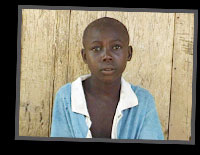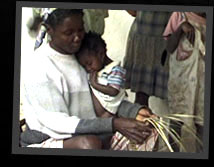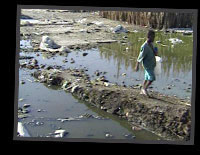
Children of Shadows 2001, 54 mins.  I had been to Haiti many times and had made four films that were about the cultural aspects of Haiti – peasant life, natural healing, Vodou. On one of the earlier trips, while I was making HAITIAN SONG, I came across a situation that stuck with me over the years. In one of the households where we were filming, there lived a small boy who did a lot of the hard work in the family, yet didn’t seem to be actually part of the family. I thought he was about 6 years old, but he was really 12 – stunted in growth due to years of malnourishment. Fifteen years later, I was still thinking about this boy, who I later learned was a restavek. Who were these children? I began to do some research and found that these were children who come from such poor families that they had be given away to other families in order to have the possibility of a better life some day. The children ended up being virtual slaves, doing all the work in the household. I applied for funds to do a film on this subject, and after receiving a small SOROS grant, went to Haiti to start documenting this. Before I went down there, many people who had grown up in Haiti told me that the situation no longer existed. Others said that even if I could find people who had restaveks that no one would allow me to film them.  Nothing could have been further from the truth. Once in Haiti I had very little trouble getting permission to interview people regarding this because nobody felt they had anything to hide; in fact they felt that they were doing something virtuous – helping children whose rural parents had difficulty providing for them. While making this documentary I made 3 trips to Haiti, working with my Haitian assistant, Carlo Thelasco. I did the shooting; he did the sound. Because we were such a small crew we could move around easily, hang out with the kids and their families, spend days just getting to know people. During the first filming trip, we spent 3 weeks in Port-au-Prince, focusing on about 6 restaveks, whom we followed throughout their day. We followed them from dawn to late at night, accompanying them on their trips to the river to fetch water and run errands; followed them as they swept and washed and cooked and cleaned. Every night when I returned to where I was staying I was completely wiped out by the emotional toll. On the second trip to Haiti, six months later we rented a jeep and went deep into the countryside to find and interview peasants who had to give away their children. These people live in such a deeply rural area that there is nothing for them to do but farm, and the land is no longer producing anything. In many places there is no public transportation and farmers have to walk many miles just to sell a branch of bananas in the market for a few pennies. The roads are so bad in Haiti that it took us 8 hours to go about 150 miles using a four-wheel drive jeep.  On the third trip, two years later, we found two of the kids (Vanya and Herode) whom we had previously filmed in order to see if/how their lives had changed. Four years later when the film was done, it went to many festivals in different parts of the world. I didn’t know how people in Taiwan, Greece, Sarajevo, etc. would relate to what I had thought was only a Haitian problem. However, in almost every country, audience members said that their country had a similar situation regarding children and work. In 2003 the film was shown in Haiti in a variety of venues, including national television. In one venue, geared toward Haitian social workers, psychologists, teachers, economists, and other human rights workers, a discussion followed the screening, with people pledging to make changing the restavek situation a priority. By no means do I think that one film can change an entrenched situation, but now people are beginning to talk about the problem and ask questions about how it can be solved.
back to top |